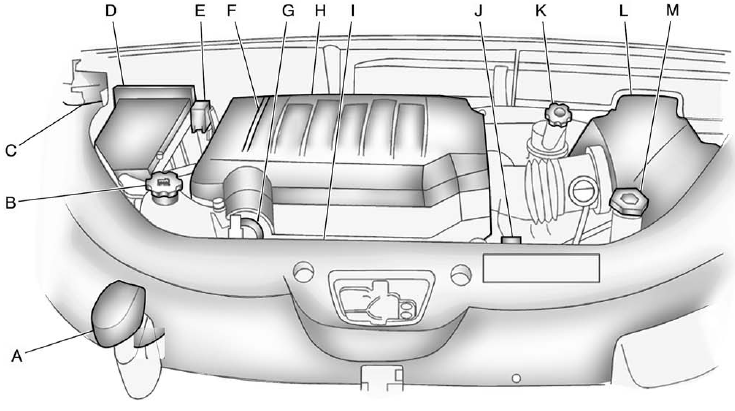Engine Compartment Overview

A. Radiator Pressure Cap. See Cooling System on page 10‑14.
B. Engine Coolant Recovery Cap. See Cooling System on page 10‑14.
C. Remote Negative (−) Terminal. See Jump Starting on page 10‑78.
D. Engine Compartment Fuse Block on page 10‑31.
E. Remote Positive (+) Terminal. See Jump Starting on page 10‑78.
F. Power Steering Reservoir and Cap (under engine cover). See Power Steering
Fluid on page 10‑21.
G. Engine Oil Fill Cap. See “When to Add Engine Oil” under Engine Oil on page
10‑8.
H. Engine Cover on page 10‑8.
I. Engine Oil Dipstick (out of view). See “Checking Engine Oil” under Engine Oil
on page 10‑8.
J. Automatic Transmission Fluid Dipstick. See “Checking the Fluid Level” under
Automatic Transmission Fluid on page 10‑12.
K. Brake Master Cylinder Reservoir. See “Brake Fluid” under Brakes on page
10‑22.
L. Engine Air Cleaner/Filter on page 10‑12.
M. Windshield Washer Fluid Reservoir. See “Adding Washer Fluid” under Washer
Fluid on page 10‑22.
See also:
Deleting a Paired Phone
If the phone name you want to delete is unknown, see “Listing All Paired and Connected Phones.” 1. Press and hold for two seconds.
2. Say “Bluetooth.” 3. Say “Delete.” The system asks wh ...
Selecting the Alert Timing
The Collision Alert control is on the steering wheel. Press COLLISION ALERT to
set the alert timing to far, medium, near or off. The first button press shows the
current control setting on the D ...
Using the Radio to Control a USB Storage Device or iPod
The radio can control a USB storage device or an iPod using the radio buttons and knobs and display song information on the radio’s display.
(Tune): Turn to select files.
SEEK: Press to go to th ...





